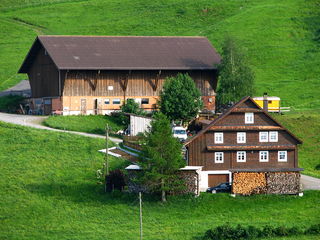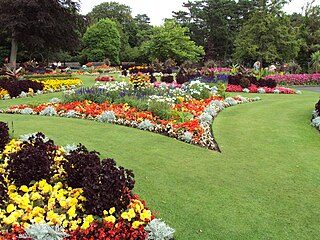
Osborne House is a former royal residence in East Cowes, Isle of Wight, United Kingdom. The house was built between 1845 and 1851 for Queen Victoria and Prince Albert as a summer home and rural retreat. Prince Albert designed the house himself in the style of an Italian Renaissance palazzo. The builder was Thomas Cubitt, the London architect and builder whose company built the main façade of Buckingham Palace for the royal couple in 1847. An earlier smaller house on the site was demolished to make way for a new and far larger house, though the original entrance portico survives as the main gateway to the walled garden.

Shorwell is a village and civil parish on the Isle of Wight, United Kingdom. It is 4 1⁄2 miles (7.2 km) from Newport in the southwest of the island. Shorwell was one of Queen Victoria's favourite places to visit on the Isle of Wight.

Whippingham is a village and civil parish on the Isle of Wight. The population of the Civil Parish at the 2011 Census was 787. It is located 1 1⁄2 miles (2.4 km) south of East Cowes in the north of the Island.

Shide is a small settlement on the Isle of Wight, some of which is considered to be in the Newport conurbation.

Steephill is a hamlet near Ventnor, Isle of Wight, previously the location of a Victorian country estate with a castle-style mansion, Steephill Castle, which was demolished to build bungalows in the 1960s. Steephill itself now forms part of the suburban development westward from Ventnor.

Victoria Recreation Ground is a park located on Recreation Ground Road, just off Carisbrooke Road, in Newport, on the Isle of Wight, England. It was opened in 1902.
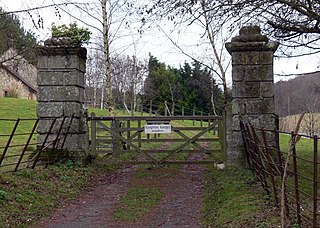
Knighton Gorges Manor was one of the grandest manor houses on the Isle of Wight. Located in the hamlet of Knighton, near Newchurch, it is reported to be one of the most haunted locations on the Isle of Wight.

Nunwell House, also Nunwell Manor, is a historic English country house in Brading, Isle of Wight. Located 3 miles (4.8 km) south of Ryde, the Tudor and Jacobean style house also has later additions. The house contains family militaria. It was occupied by the Oglander family from Norman times until 1980. Nunwell House is a Grade II* listed building.
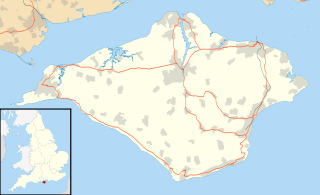
Gatcombe House is a manor house in Gatcombe on the Isle of Wight, England. The original building was constructed by the Stur (Estur) family as noted in the Domesday Book. St. Olave's Church, built next to the manor to serve as its chapel, was dedicated in 1292. It also belonged at one time to the Lisles of Wootton.
Merston Manor is a manor house in Merstone on the Isle of Wight, England. The manor was first mentioned in the Domesday Book. Prior to the Norman Conquest, Merston Manor was owned by the Brictuin family. The present home, built in 1605 in the Jacobean style by Edward Cheeke, was rebuilt in the Victorian era. This structure may be the oldest brick house on the Island. The manor now belongs to the Crofts family.
Billingham Manor is a manor house lying about a mile south of the village of Chillerton on the Isle of Wight.

Wolverton Manor is a manor house in Shorwell, on the Isle of Wight, England. The original house was started by John Dingley, Deputy Governor of the Isle of Wight. The Jacobean style home, built by Sir John Hammond after the death of Sir John Dingley, is the second house built on the site. There is a two-storey porch which features a flat roof and hollow angle columns.
St. Clare Castle was a castellated mansion in Appley on the Isle of Wight. It was the family seat of St Clare, Appley. Her Majesty Queen Victoria and the Prince Consort visited several times, while Princess Alice and Prince Louis honeymooned at St. Clare in 1862. St. Clare Castle is situated on the coast, about a mile east of Ryde. It was the seat of Colonel Francis Vernon-Harcourt. The grounds and gardens are extensive.
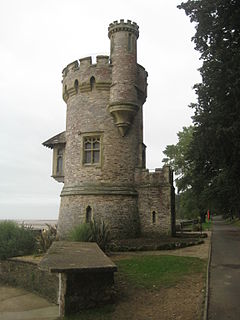
Appley Towers, also called Appley Tower or Appley Tower House was an English country house near Appley House in Appley, Isle of Wight. It was the home of the Hutt family, who bought it in the 1870s, and later of Sir Hedworth Williamson. The house has been demolished, but a number of its estate buildings survive.
Appley House is an English country house and abbey in Appley Rise, Ryde, Isle of Wight.

Great East Standen Manor is a manor house on the Isle of Wight, England. Its history dates to the Norman Conquest; and it was allegedly once the residence of Princess Cicely, the daughter of Edward IV, following her third marriage to Sir Thomas The front is 18th-century and includes five bays that are irregularly spaced. Grey headers and red brick dressings are featured, as are windows with slightly segmental tops and a large chimneystack, dated 1768. The 18th-century Standen House is nearby.

Standen House is an English country house located 1 mile (1.6 km) south of Newport, Isle of Wight. The 18th-century house has a brick front and features seven-bay windows, a porch with Doric columns, and triglyph frieze. Made of brick, it is located at the base of Pan Down. To its right is situated the park of Gatcombe, which itself lies in a valley which includes the winding River Medina. Gatcombe House lies opposite Standen House, separated by the river and woods. Great East Standen Manor is nearby.
Thorley Manor is a manor house just outside Yarmouth, on the Isle of Wight, England. Built in 1712, it features a modillion cornice, hipped roof, as well as tall chimneys.

Sheat Manor is a manor house in Chillerton, on the Isle of Wight, England. Considered to be one of the island's antiquities, Sheat manor house, is a fine old gabled mansion now used as a farmhouse. It has a pond and swans. It contains some interesting Jacobite carving. Sheat was one of the few properties whose Anglo-Saxon owner, Alaric, was not disturbed by the Norman invasion. It was run by the Urry family for some time.

Landguard Manor is a manor house in Shanklin on the Isle of Wight, England. Mentioned in the Domesday Book, over the centuries it was home to numerous notable gentlemen. It is a Grade II listed building. One of the finest known portraits by Sir Thomas Lawrence, English portrait painter and president of the Royal Academy, is located in its drawing room.




